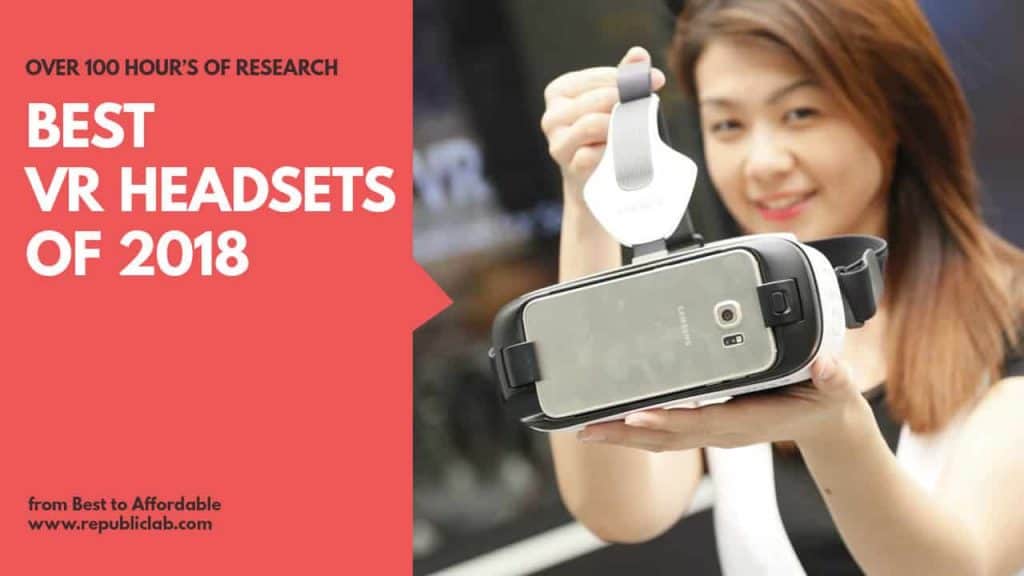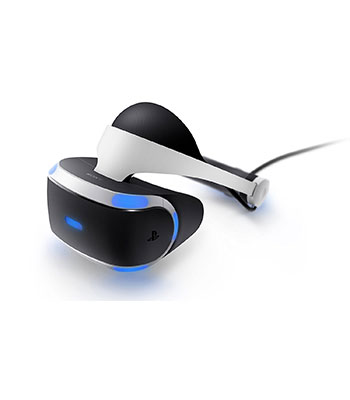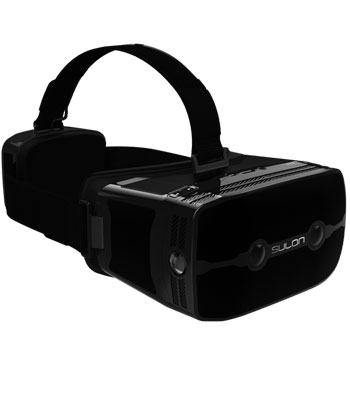Top 10 Best VR Headsets of 2023 - Buyers’ Guide

Best Selling Virtual Reality Headsets of 2023 (Top 10 List)
Modern science and technology has been providing us with varieties of newer and smarter products one after another over the last decade and Virtual Reality shortly known as VR is one of the most fascinating addition to this list.
With its motion tracking and eye tracking features it really takes us to an exciting virtual world and makes us feel as if we are actually there.
Although the concept of the virtual reality is not new altogether so as to say but the incorporation of cutting edge technology to this concept in recent years has given birth to some innovative products which are truly more exciting than ever.
And now we actually belong to the VR generation as this technology has entered every step of our life.
As the VR arena is full of various kinds of virtual reality headsets it could be a baffling situation for you to reach the right buying decision. To make things a bit easier we have assorted 10 best models which are ruling the market at present.
Just have a look at them and find out which one suits you the most.
Top 10 VR Headsets (Recommended By Experts)
1. HTC Vive
HTC Vive is indisputably one of the best products that offer the most comprehensive VR experience to the users. In addition to the two base stations to be used for tracking the movement of the headset the device also includes a couple of motion controllers inside the box. And they really provide more engaging experience compared to traditional controllers.
Key Features
HTC Vive sports two 1080p screens that offer highly crisp image although this is not quite a high resolution so as to say especially when juxtaposed with some of its close rivals.
The most distinguished trait of this headset is its room-scale feature that allows the user to roam around a 4.5×4.5 meter of space. This truly adds to the realistic environs which can be experienced while wearing it.
In other words you are not merely pressing the analogue stick but also utilizing your legs at the same time to walk over. However you must have that much space in your room to enjoy the feature.
PROS
- One of the best VR experiences
- Having Valve as software partner
CONS
- Highly expensive
- Requires a highly efficient GPU
2. Sony PlayStation VR
PlayStation VR is definitely a quality VR available at an affordable price. The most remarkable thing is that it is neither too pricey itself nor it requires expensive high end gaming PCs to run it.
Key Features
Only a PS4 console is enough to run it. It is offered in two variants – the basic one includes the VR system and the headphones along with the cable requirements.
The enhanced pack known as PlayStation VR Launch Bundle comes with a number of stuffs such as PlayStation camera, motion controllers and a copy of PS VR Worlds in addition to the basic pack contents.
Those who do not have the PS camera and the motion controllers should go for the bundle pack to get the most out of it.
As the device equips only one camera in place of two it is a bit difficult for the VR to keep track of you properly in case you walk around.
But this is not the case with HTC Vive that uses two cameras that enables it to provide an efficient room-scale virtual reality.
PROS
- Quite affordable
- Almost PC level performance
- Nice selection of games
CONS
- Lacks some essential accessories
- Blemished motion controller tracking
- Issues with sealing out lights
3. Oculus Rift
Oculus Rift demands a high end gaming PC to gather the required power for generating the two 1080*1200 resolution of images for the headset.
Key Features
The minimum specs asked for by Rift were originally Intel Core i5 4590 processor or its equivalent, 8 GB RAM, and Radeon 290 or GTX 970 video card.
However the requirements have been brought down to a comparatively lower level in recent days. So this is obvious that to effectively utilize what Rift offers you must make a good initial investment to your PC first of all if it is not so far accordingly equipped.
And needless to say there is also the cost of the headset itself at the top of that.
But when clubbed with the best of the hardware Rift offers a performance which is far superior to Samsung Gear VR, Google Cardboard or PlayStation VR.
PROS
- Fits very comfortably
- Coolest VR games
- Increasing list of apps and movies
CONS
- Extensive PC requirements
- Tendency to cause nausea
4. Samsung Gear VR
The new Samsung Gear VR is quite identical to its predecessor Note 4 Gear VR except for the size and weight. Yes it is smaller and lighter.
Key Features
The straps are made more comfortable in addition. Despite much improvement inside the image seems a bit fuzzy which can be looked upon as a downside of the device.
But overall it is quite efficient as a home entertainment VR device and for watching different kinds of videos.
Playing games can also be highly exciting through this nice device.
One thing which you might look upon as a drawback is that only a handful of premium range Samsung smartphones fits into Gear VR.
And the reason is pretty simple – these high end phones feature quite higher resolutions and powerful processors and hence they can offer the best possible VR experiences which is not possible for lower range smartphones.
PROS
- Smaller design
- Effectively lightweight
- Convenient for spectacles wearers
CONS
- A bit expensive compared to its benefits
- Compatible only with Samsung smartphones
- Limited games and other contents
- Might cause nausea
5. Google Cardboard
Google Cardboard is a most simply designed low cost fuss-free solution meant for converting a simple device into one which can facilitate watching VR contents.
And as suggested by the name itself it is just a piece of cardboard with a couple of powerful lenses inside it.
Key Features
Some viewers are made to support different apps the number of which is still increasing. There are in fact several manufacturers that work well with Cardboard products such as Zeiss VR and View-Master.
If you are to buy a “Works” along with the Google Cupboard you must have a right tray in the viewer into which your existing phone can be placed.
Suppose if the next phone you purchase does not fit into it the product will be of no use then and you will always have this limitation.
PROS
- Highly affordable
- Offers a host of free apps
- Wide range of viewer choices
CONS
- Plenty of navigation option including many poor ones
- Huge discrepancy in content quality
- Viewers are not long lasting
6. LG 360 VR
LG 360 VR is different from the other VR systems discussed so far in terms of its tethering abilities.
Key Features
This VR headset connects to a compatible LG handset via USB cable (type-C) instead of being placed inside the VR box as is the case with many VR devices. There are differences in other aspects as well. It is made is
There are differences in other aspects as well. It is made is shape of a pair of glasses which we are found to wear very often. Thus it is better than other VR headsets as you don’t need to carry a bulky device on your face throughout the time.
It is more like a diving mask worn by the swimmers and divers. Moreover it is extremely comfortable to put on and evidently much more lightweight. You also get a padded support for your nose and same is there in its arms.
The headset equips two 1.8 IPS displays each having 960*720 pixels of resolutions that result in 639 ppi.
PROS
- Extreme wearing convenience
- Highly Portable
- Convenient tethering connectivity
CONS
- Not conducive to free movement
- Cannot block out external lights effectively
7. Google Daydream
With no requirement for any additional computer and inconvenient wires or tethering Daydream is perfectly a mobile VR device. It is quite similar to Samsung Gear VR in terms of designing concept but different in other aspects.
Key Features
Daydream is distinguished from other VR headsets including the Gear VR by virtue of its handheld remote which allows you to interact with the VR experiences. And the setup demo is a good enough to familiarize you with its operations.
While the VR Gear is an all-plastic shell the case is largely different with Daydream which is created with soft cushy cloth along with foam innards making it one of the most comfy VR headsets so far.
However there is a firm plastic frame inside the comfortable cushion to give it the required rigidity.
Again unlike Vive and Rift Daydream which rely on expensive phones as their display unit, Daydream uses a Pixel phone for this purpose.
PROS
- Quite affordable
- The most comfortable to wear VR headset
- Many apps and games
CONS
- Chances of slipping down due to lack of a supporting overhead strap
8. Microsoft HoloLens
Unlike most of the headset in this list (except for the LG 360 VR) HoloLens is fairly diminutive and lightweight. But apart from its wearing comforts there are more significant aspects of it.
Key Features
There is no cable attachment so you are free to move around without any fear of being tripped over. Moreover it actually drifts over your face instead of resting on your nose offering you an extremely comfortable wearing experience.
There are two inbuilt speakers which saves you from wearing any additional headphones. Moreover there is learning of complex swipe command as HoloLens is managed by gestures of eyes, hands and voice.
The main difference between HoloLens and other VR headset is that in HoloLens you are actually faced with a display screen which hangs over in front of your face instead of wrapping around the whole visor as in other VR systems. Thus it resembles the Google Glass in this respect.
PROS
- High potential VR system
- Comfortable to wear for any length of time
CONS
- The screen seems too small
9. Sulon Q
Sulon Q is so some extent similar to the HoloLens in terms of its non-attachment with any wired connectivity as it is a standalone unit that processes the images itself and hence requires no PC or a smartphone to be connected with.
Key Features
The headset is powered by AMD FX 8800P quad core processor combined with a Radeon R7 graphics. This means it can run DirectX 12 as well as Vulcan graphics APIs offering very high performing visuals.
There are also microphones with noise-cancelling features to be used for voice communications.
The screen sports a 2560*1440 OLED display and the audio is provided through the inbuilt ear-buds that supports 3D spatial audio. The lenses placed on the front are meant for Augmented Reality applications.
PROS
- High end specifications
- Stunning Graphics quality
- Equips wireless VR technology
- Features Augmented Reality
- Supports voice commands
CONS
- Relatively costlier
10. Homido Virtual Reality Headset
The most exciting and advantageous thing about Homido VR Headset is that it has been wisely designed in a way so as to allow any smartphone to work with it.
Key Features
It utilizes the concept as used in Google Cardboard. Its plastic contruction resembles that of Samsung’s Gear VR to a great extent however unlike Gear VR which supports only a few Samsung phones, Homido headset is universal.
The two dials on the headset can change the actual distance of the smartphone display and also the distance existing between the two lenses offering you a better and convenient viewing experience.
Homido has got the app of its own called Homido Center which guides you regarding the use of the VR headset. But you can enjoy any app that is meant for VR system along with this Homido headset and they really work well.
PROS
- Accepts all smartphones irrespective of the make
- Supports all existing apps so far
- Soft cushy built
CONS
- Seems a bit overpriced










